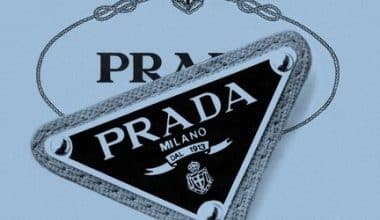The Gucci logo is one of the most well-known and iconic logos in the fashion industry. It’s also a great example of how a logo can evolve over time while still maintaining its core meaning. In this post, we will take a look at the Gucci logo, what it symbolizes, and how it has evolved since its inception. We will also explore the history of the brand and how it has become one of the most successful fashion brands in the world.
The Different Types of Gucci Logos
The Gucci logo has undergone several iterations since the fashion house was founded in 1921. The interlocking “G”s of the current logo were designed by Aldo Gucci in 1933 and have become one of the most recognizable logos in the world.
While the basic design of the logo has remained relatively unchanged over the years, there have been some slight variations. For example, the spacing between the letters has varied, and sometimes one of the “G”s is slightly longer than the other.
There are also some rarer versions of the logo that feature additional elements. One version includes a snake wrapped around the letters, while another features a laurel wreath. These variations are generally only used on special edition products or limited edition items.
History of Gucci
Guccio Gucci, who started Gucci, got his idea from the high-quality luggage he delivered to hotel guests in Paris and London when he worked there. Gucci came to Florence in 1920 to begin a small shop selling quality leather products. Gucci worked with skilled artisans who made the things he sold by hand, paying close attention to every detail. The business was a success, and Gucci quickly extended the brand by opening more stores in Milan and Rome with the help of his three sons.
Gucci had established itself as a prominent luxury brand by the 1950s. Rich and famous people all wanted Gucci products, and the brand really started to stand out as the leader in high-end fashion.
Gucci now has $4.3 billion in revenue and is the world’s best-selling Italian brand. Gucci items were once the most copied in the world, inspiring more imitators than even well-copied brands like Rolex.
Given all of this, it’s easy to argue that Gucci has a lengthy and storied history. However, what part did the brand’s logo play in this, and what is the history of the iconic Gucci logo?
A Brief History of the Gucci Logo
The distinctive Gucci symbol was brought to life by Aldo Gucci. Since then, the old Gucci emblem has followed the company. Other variants of the Gucci symbol are quite rare. If you’re ready to pay a premium, you can find some vintage Gucci brand things.
For example, after Guccio Gucci died in the 1950s, Aldo took over the store. For a short period, Aldo elected to change the label’s emblem with a depiction of a knight standing within a shield.
The knight carried a set of bags, similar to a lesser-known 1930s version of the image with a bellboy. To represent aesthetics, the complicated logo incorporated a Gucci wordmark on a banner, a rose, and a rudder.
Gucci was also using the double G logo as a registered trademark at the time, which was printed on luggage, small leather products, and bags. The print evolved with the company, appearing in new stores and collaborations until the knight design was forgotten.
Read Also: NETFLIX LOGO: Evolution & Tips on Digital Branding
Gucci is one of the few fashion businesses that has used the same symbol for so long. Products bearing the same Gucci mark that were introduced decades ago are still in high demand today.
People desperate to recreate and profit from some of the magic have created innumerable imitations of the Gucci symbol.
Importantly, while Gucci logos have stayed mostly consistent over the years, the rights to the Gucci insignia were a topic of contention in 2012. Gucci’s trademark expired in 2012 due to complications with intellectual property legislation in the UK, and the brand failed to renew it on time.
Despite going to court to challenge the decision to revoke the trademark, the company finally lost its case. Gucci still does not have a logo trademark in the United Kingdom.
Fortunately, this has not had a significant impact on the company’s ability to retain a solid global image.
The Evolution of the Gucci Logo
The Origins (1921–1955)
Guccio Gucci, a Florentine, had spent part of his adolescence working at the Savoy Hotel in London, where he learned about aristocratic tastes, the best luxury products, and material excellence. Back in Florence, he launched his first workshop in Via Della Vigna Nuova, producing saddles and luxury suitcases.
The initial brand that distinguished these products was a basic label bearing Guccio Gucci’s name, references, and address. The first logo, in italics, was created in 1923, inspired by the founder’s signature, which was relatively plain and neutral at the time, to which Guccio’s “G” was added before his surname in 1929.
This was one of the brand’s longest-lasting logos (it was used during Frida Giannini’s time in charge), but in 1934, a taller, edgier one with an aristocratic hotel porter holding his small marsina and two bags was chosen. The odd brand did not stay long because it was used as the foundation for Maison’s next logo.
The Knights’ Age (1955–1992)
The brand looked very different in the 1950s. The first boutique in Milan opened in 1951, the first in New York in 1953, and the transfer of power to Guccio’s son Aldo occurred that same year.
On the level of the logo, two major events occurred: the first was the replacement of the actual logo on the label by a knight in the heraldic field, who held the same suitcases as the bellboy in the 1930s logo, evoking a world much higher than that of hotels, with, on his head, a rose and a rudder, to symbolize aesthetic sense; the second was the spread of the “double G,” designed by Aldo Gucci in.
However, under the knight, the name Gucci was returned in 1958, in a linear and spaced character, which subsequently became more full-bodied and equipped with thanks from 1971. It was the beginning of the contemporary logo for the brand.
The Contemporary Era (1992–2019)
The “double G” monogram became increasingly popular throughout time and was offered in an unlimited number of various forms and variants. Finally, in the early 1990s, the “double G” became part of the official mark of the brand, which stayed unchanged until Tom Ford took over the Maison and presented a version with just the most tapered and spaced letters and characters.
The logo was originally printed on a black label, but with the entrance of Alessandro Michele in 2015, the label was enlarged and became white. Michele’s most recent innovation in 2019 is a new form of the “double G” with two overlapping and right-oriented characters—unlike the original monogram, this is the first to also exist as a corporate trademark.
What is the Importance of the Gucci Logo?
The previous Gucci emblem, as well as the sign we know today, is straightforward. According to Gucci, this logo was intended to be a depiction of Guccio Gucci’s name. The Gucci sign was easier to use on various products than the original wordmark.
The design of the logo also resembles the links of a bracelet, lending credence to the company’s image as a luxury brand.
Gucci’s double G logo has been proposed in numerous forms and variations. Gucci recently experimented with a handwriting-style wordmark. However, it’s difficult to imagine anything replacing the official Gucci symbol in the future.
The unique symbol is one of the most well-known trademarks in the world, and it can now be found in a variety of the brand’s fashion products. The Gucci mark serves as a stamp of approval for what many consider to be the world’s most attractive apparel and accessories.
When someone with unlimited funds spends a fortune on Gucci, you know the emblem is appealing.
The Story of Gucci’s Founder
Guccio Gucci, who was born in Florence, founded the label. He was the son of a leatherworker. Guccio Gucci moved from Italy to Paris in search of success, eventually landing a job as a bellhop at the Savoy hotel in London. While not glamorous, his employment as a porter allowed him to closely examine the high-end clientele.
He had a good look at the fashionable folks whose luggage he had to handle. They not only dressed in fine clothing, but their luggage also represented their social standing. He discovered that fashion was made up of more than just garments.
While transporting luggage, he learned to identify each variety and the differences in quality. He noticed that the quality of bags was heavily influenced by their design—and that design was a key factor in distinguishing between high-end and low-end pieces.
Guccio discovered that the textiles or materials used in high-end luggage are as important as the construction and design. Armed with his knowledge, he returned to Florence and established the House of Gucci in 1921, a boutique specializing in high-quality leather goods.
The Troubles of the Gucci Clan
However, by the 1970s, the company’s fortunes had begun to deteriorate. Family feuds between Guccio’s sons grew common, with each attempting to establish an individual business and capitalize on the name. The company’s finances were in the red, and it eventually became a publicly traded company from a family business in 1982.
Then, Rudolfo Gucci’s son, Maurizio Gucci, sued his uncle Aldo for ownership of the company. In 1986, the 81-year-old Aldo was sentenced to prison for tax evasion. In 1988, Maurizio sold a controlling interest to Bahrain-based Investcorp, and the firm gained entire control of the brand from the family in 1993.
The Gucci family conflict lasted much longer, culminating in Maurizio’s fatal shooting by a hitman in the brand’s Milan store. Patrizia Reggiani, Maurizio’s ex-wife, was arrested for hiring the hitman and sentenced to 16 years in jail for her role in Maurizio’s murder.
Fortunately for the firm, fashion designer Tom Ford took over as creative director in 1994. His 1995 collection, which included dresses with prominent cuts and many other explicit designs, brought the spotlight back to fashion. It was able to reestablish the brand’s position in the fashion business.
What Exactly Is the Gucci Logo?
Now that you know who started Gucci, tell us about the logo.
As previously stated, the Gucci emblem features two interwoven Gs in a modern typeface. It is one of the world’s most well-known logos. The Gucci sign has come a long way since its humble beginnings as a brand for high-end bags.
Throughout the years, the corporation has employed numerous variants of the renowned monogram logo. The ends have frequently overlapped, and it has also been depicted in a manner evocative of another legendary fashion house, Chanel. The basic rendering of the logo, however, has been kept.
The Gucci logo was registered as a trademark in 1955. When the logo appeared in print on some bags, it somewhat altered the design. Today, all Gucci prints use this modified design, with one G upside down and the other right-side up.
Alessandro Michele, on the other hand, decided to modernize the legendary logo. The new logo debuted in the 2020 fall/winter menswear collection: the word “Gucci” written in a child’s handwriting. The logo was also modified on the brand’s social media accounts.
The new logo elicited conflicting reactions. Most thought it was a significant departure from Gucci’s iconic emblem, and that it was not a sensible branding or economic move. Many individuals were perplexed by the revamp, unsure what the bare-bones, infantile scrawl represented for a luxury company known for its loud, chaotic style.
What Does the Gucci Aesthetic Look Like?
Gucci’s style might be described as “geek chic.” Gucci items are very loud and frequently incorporate a plethora of components. It is easily recognized, and Gucci has maintained the “extra” aesthetic throughout the years.
Gucci’s logo is timeless. It’s simple, yet the typography is contemporary. The Gucci double Gs are sans serif, yet the logotype is in a serif font. The overall appearance of the logo conveys confidence.
What Are the Colors of Gucci?
The colors of the Gucci emblem are black and white. These two contrasting, classic hues are used to create the logo. This allows the designs to shine out against the busy prints and motifs used.
Throughout the years, several more important branding features have been connected with the Gucci moniker. Its expanded brand palette also includes the distinctive red, white, and green stripes of the Italian flag.
The coral asp snake is another well-known Gucci symbol. The Gucci snake appears as one of the Gs in buckles, fastenings, and footwear designs.
Gucci incorporates the snake into its footwear, backpacks, skirts, and sweaters. It is frequently seen alongside its conspicuous stripes, which are rendered in red, black, and white.
The Gucci bee is another popular symbol right now. Their footwear, purses, wallets, watches, belts, and home décor pillows all depict the bee. Gucci stripes are frequently seen on wallets, footwear, and belts. The Gucci bee is as distinctive as the company’s double G emblem. It is frequently used without the official logo.
Gucci’s apparel and designs, on the other hand, do not adhere to a specific color pallet. The company is known for going beyond the use of colors and patterns, and the brand’s chaotic aesthetic ensures that its collections showcase a riot of colors.
The Gucci Logo’s Popularity
One of the most telling signs of the Gucci logo’s appeal is that it can be found on some of the world’s most trendy clothes and accessories. When individuals who can afford to wear anything refuse to wear anything with the Gucci emblem, you know the logo has some attraction and popularity.
Another aspect of the Gucci logo’s appeal that the brand would presumably prefer to avoid is the amount of effort that imitators put into replicating the Gucci emblem demonstrates the significance of having the design appear precisely perfect.
Finally, the endurance of the Gucci emblem demonstrates its appeal. While there is undeniably some thrill in frequently altering your logo (as Google does), there is also something to be said about a design that has lasted the test of time, and the test of time is one that the Gucci logo has passed with flying colors. The logo has been present for more than 80 years, and it would not be surprising to see it around for another 80. As long as the acclaimed Italian brand reigns supreme in the luxury fashion sector, its trademark double-G emblem will stay prominent.
Evaluation of Logo
While the Gucci logo is one of the most identifiable marks in the world, does it do well in the four criteria that distinguish the best logos from their weaker counterparts? Let us find out.
#1. Relevance
Is relevance essential? Can’t we just pick any symbol to symbolize our brand? What makes a logo memorable?
Yes, staying relevant is essential, especially when it comes to a company’s visual brand. A relevant logo clarifies what a company is all about. It helps to clear the air by offering important brand information.
A corporation uses a variety of tactics to make its visual brand more relevant. A corporation ensures that the logo communicates exactly what the brand is all about, from the color palette to the fonts to the use of numerous symbols.
The Gucci logo is a superb example of a relevant logo. The wordmark and symbol clearly communicate the nature of the business. The interlaced “Gs” with “Gucci” written above have come to represent fashion.
#2. Memorable
When you see a good logo, you usually remember it. When you notice the brand’s emblem, you begin to learn more about it. A good logo’s purpose is to make a strong connection with the consumer so that they become more interested in learning more about the brand it represents.
Customers’ attention is always drawn to the Gucci logo. In a matter of seconds, it establishes contact with any type of customer.
The originality of a memorable logo is one of its most crucial characteristics. The Gucci emblem is genuinely one-of-a-kind in every way. The perfectly placed double-G is a joy to see.
#3. Simple
Because the brain is preconditioned to remember basic things, when a design is simple, the brain readily accepts it. Another crucial component of a simple design is its capacity to effectively communicate. A simple and minimalist logo is direct and does not waste time.
A simple design can be created by distilling concepts to their most basic form. Another technique to achieve simplicity is to use negative space and remove any clutter from an existing logo.
The Gucci emblem is as simple as one may imagine, but it packs a powerful punch. The basic Gucci logo is so effective that designers and marketing experts from all over the world study it!
#4. Timeless
The eternal nature of a logo is one of its distinguishing features. Few logos have withstood the test of time as well as Gucci’s. Gucci’s emblem has never changed throughout its 80-year history.
The Gucci emblem has been around for over 80 years and has always found a way to change and stay current. The most crucial characteristics of a timeless logo are that it always finds a way to be fashionable, never goes out of style, and adapts. The Gucci emblem is a true classic.
In the logo test, the Gucci logo scored more than the maximum. The Gucci logo has been declared the winner over time, so any attempt to determine whether it meets the many requirements of an iconic logo is futile.
Final Thoughts
Gucci’s significance to the fashion world is obvious. Gucci has come a long way from its humble beginnings as a leather goods manufacturer to its current status as the world’s top clothing and accessories manufacturer. The distinctive Gucci logo has been the cherry on top of this fashion behemoth. The Gucci logo is timeless, iconic, relevant, and straightforward.
Related Articles
- The Most Valuable Fashion Brand In The World
- BAG BRANDS: 2022 Top 25+ Luxurious and Designers Bag Brands
- BAG BRANDS: 2022 Top 25+ Luxurious and Designers Bag Brands
- Most Valuable Fashion Brand [3 lessons to learn]
- Luxury Bag Brands: Top 2022 Luxury Handbag Brands List (Updated)






